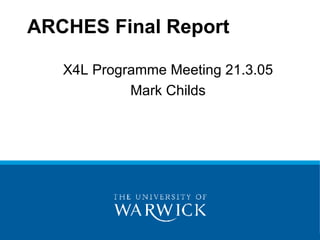Design principles for digital repostories March 2005
- 1. X4L Programme Meeting 21.3.05 Mark Childs ARCHES Final Report
- 2. Main achievements and findings Repository designed and built which seamlessly links assets, learning objects and evaluation of their use. Functionality to enable discovery trails within learning objects and assets designed and tested 600 images uploaded with associated metadata VRA Core metadata schema modified for use with digital images Repository piloted with learning activities Pilot of practical application of UK LOM Core
- 3. Main achievements and findings Sample learning objects created and deposited in a variety of VLEs and in RELOAD Process for economic and efficient creation of metadata piloted Recommendations for effective use of learning objects within learning and teaching established Advice on creating effective educational metadata delivered Advice on essential requirements for creation and design of repositories established
- 4. Main lessons learned Creation of digital repositories Cataloguing of large numbers of visual resources The creation and use of learning objects Contracting software vendors to develop bespoke software
- 5. Creation of digital repositories Essential elements of a digital repository are: It should be easy to use It should work through a standard web browser (since few users have the administrative rights to download software to their PC) All but the minimum of metadata to be autogenerated, because students are creating learning objects and it is important that the process of creating metadata does not discourage them from creating the learning objects.
- 6. Creation of digital repositories balance the work required in putting resources in with the work required in pulling resources out, i.e. reduce metadata as much as is feasible (but not more) individual bespoke repositories that are interoperable are preferred by users to centralised repositories specific design of the functionality of a repository must be carried out through a series of reiterative steps, each step focusing on the needs of the users, including metadata creators, depositors, teaching staff and students.
- 7. Cataloguing visual resources Level 1 learning objects (referred to as assets or as resources within the ARCHES project) need different metadata schema to describe them, than level 2 or above learning objects. The descriptive metadata for visual resources is highly important. Metadata schema such as VRA Core need adaptation to make them suitable for digital resources
- 8. Cataloguing visual resources There is usually a range of existing metadata associated with a resource (e.g. filenames, directory pathnames) that can be used to catalogue a resource. Good quality contextual information must be generated by subject specialists, whose IT literacy will vary enormously. Making the creation of metadata as effective and as economic as possible requires close management of the workflow.
- 9. Creation and use of LOs The greater pedagogical value of learning objects is as materials to be created by students rather than for students. The greater barrier to the effective use of learning objects by students is not that of IT literacy, but of information literacy. Students need guidance and instruction in effective searching for and processing of information.
- 10. Creation and use of LOs The issue of the students being unsure if the information they have gathered is complete can be addressed by asking them to present the LO in class The use of reflection on one’s own and other’s work is a useful task, but there is a wide range in abilities and experience at doing this for which students need explicit instruction.
- 11. Software vendors It is important to appoint an independent consultant who can both translate between the vendors and academics and arbitrate between them.











